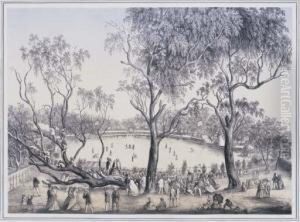Charles Johannes Theodore Troedel Paintings
Charles Johannes Theodore Troedel, often known simply as Charles Troedel, was a notable German-Australian lithographer and printer during the 19th century. Born in 1836 in Hamburg, Germany, Troedel moved to Australia in 1860, where he made significant contributions to the printmaking industry and the visual documentation of Australian life and landscapes during the colonial period.
After settling in Melbourne, Victoria, Troedel quickly became involved in the burgeoning print scene. He established his own lithographic firm, Troedel & Co., which produced a wide range of materials, including commercial stationery, maps, plans, advertisements, and artistic prints. One of Troedel's most renowned works is the 'Melbourne Album,' completed in 1864, which consisted of 24 views of Melbourne and its surroundings. This album is considered a significant record of the city's early development and a fine example of colonial artistry.
Troedel's impact on Australian art and printing was considerable. He embraced and promoted the lithographic process, which allowed for the widespread reproduction of images. His firm became synonymous with high-quality workmanship and was one of the leading print houses in Melbourne. Through his work, Troedel provided a valuable pictorial history that captured the transformation of Australia's urban and rural environments.
Beyond his professional achievements, Troedel was also a respected member of the Melbourne community. He was known for his entrepreneurial spirit and his dedication to the craft of lithography. Troedel's legacy lived on through his contributions to the visual arts and the continued operation of his printmaking firm by his descendants.
Charles Troedel passed away in 1906 in Melbourne, leaving behind a rich body of work that continues to be studied and appreciated for its historical and artistic value. His contributions have been acknowledged through the preservation of his works in various institutions and collections, including the State Library of Victoria, which holds many of his prints and the original plates for the 'Melbourne Album.'
